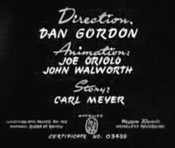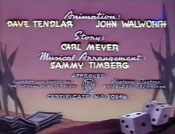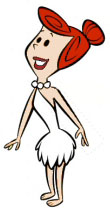 Walworth at Fleischers. John C. “Wally” Walworth Jr. is perhaps best known for creating memorable premiums (sometimes in cereal boxes) for a variety of characters and firms. However, he got his start in animation including time at Fleischer/Famous beginning in 1938 and lasting through 1944. He married Fleischer receptionist Mildred Barth who was the first girl he met in Miami. When he quit Famous in 1944, he entered the premium business working for Robert L. Weil of Advertisers’ Service Division, later Specialty Advertising Services and Advertising Specialties.
Walworth at Fleischers. John C. “Wally” Walworth Jr. is perhaps best known for creating memorable premiums (sometimes in cereal boxes) for a variety of characters and firms. However, he got his start in animation including time at Fleischer/Famous beginning in 1938 and lasting through 1944. He married Fleischer receptionist Mildred Barth who was the first girl he met in Miami. When he quit Famous in 1944, he entered the premium business working for Robert L. Weil of Advertisers’ Service Division, later Specialty Advertising Services and Advertising Specialties.
 “I was back to being an in-betweener. I started working on Betty Boop and Popeye cartoons with people like Dave Tendlar and Shamus Culhane. They had fired a guy who had been assistant animator and they gave me the job in Dave Tendlar’s group. That was around the time of Gulliver’s Travels (1939) and I worked on that film. I soon became an assistant to Culhane and worked on Nix on Hypnotricks (1941) about Olive Oyl sleepwalking through a construction site barely missing beams. Culhane helped me be a better animator. I helped him on his sequences for Mr. Bug Goes To Town (1941).
“I was back to being an in-betweener. I started working on Betty Boop and Popeye cartoons with people like Dave Tendlar and Shamus Culhane. They had fired a guy who had been assistant animator and they gave me the job in Dave Tendlar’s group. That was around the time of Gulliver’s Travels (1939) and I worked on that film. I soon became an assistant to Culhane and worked on Nix on Hypnotricks (1941) about Olive Oyl sleepwalking through a construction site barely missing beams. Culhane helped me be a better animator. I helped him on his sequences for Mr. Bug Goes To Town (1941).
 “My good friend Joe Oriolo drafted the concept of the character of Casper, the Friendly Ghost. He was paid a small amount for the initial plot but Paramount made plenty off of the idea. It was made into the film The Friendly Ghost (1945) for which I did the majority of animating in 1944. I drew Casper as a kind of ectoplasmic plastic bag but his features are more humanized now. It was to be my last big animation job. My daughter Joan was a new born and the premium business was more lucrative than animation. When I left animation I was paid $5,000 a year. I started in the premium business at $7,500 a year.”
“My good friend Joe Oriolo drafted the concept of the character of Casper, the Friendly Ghost. He was paid a small amount for the initial plot but Paramount made plenty off of the idea. It was made into the film The Friendly Ghost (1945) for which I did the majority of animating in 1944. I drew Casper as a kind of ectoplasmic plastic bag but his features are more humanized now. It was to be my last big animation job. My daughter Joan was a new born and the premium business was more lucrative than animation. When I left animation I was paid $5,000 a year. I started in the premium business at $7,500 a year.”
Jean Vander Pyl. From the Asbury Park Press newspaper May 15th, 1994 in a series of columns by Mark Voger, voice actress Jean Vander Pyl shared the following:

“It’s been wonderful for me and I’ll tell you why. When I was young, I wanted to be a famous dramatic actress like Katharine Cornell or Helen Hayes, the first lady of the theater. My only disappointment – though I’d worked through the years and had a wonderful career – was that I was anonymous. I wasn’t recognized on the street. But that was okay because I really ended up having the best of both worlds. If I wanted to appear famous, I could just tell people I was Wilma Flintstone.
“But I didn’t have to suffer through some of the hard part that stars really have to go through today where they can’t go to a restaurant without being besieged. When I meet people today of all ages, they say, ‘I grew up with you’. I’ve had so many people come up to me and say that. And the most charming and touching thing is that so many of the baby boomers were latch-key kids and I’ve had people say, ‘You were my mommy and daddy. I came home every afternoon after school and watched you’. I’ve had people thank me for all the years of pleasure and fun. I’ve never thought of myself as having that kind of effect. It’s so gratifying to me now. I think, ‘Gee Whiz, maybe I did do something after all’. So it has been very gratifying but mostly it made me feel good that maybe we made a portion of the children of this last century feel good about something and enjoy something. And laugh.”
The Fastest Pig. In the New York Times August 9th, 1992, animator and director Chuck Jones said, “When I was younger I was so ashamed of my drawings despite the support of my uncle. I told him ‘It’s no good. You can’t make a race horse out of a pig’. He replied, ‘No, but you can make a pretty fast pig.’ I decide to become the fastest pig in the world.”
Lost Daffy Duck. When we talk about “lost” animation, how many commericals and public service announcements featuring familiar animated characters have disappeared over the decades? In 1992, an animated Daffy Duck decides to go on vacation and discoves that his favorite marshes are being developed, degraded and despoiled. “This is des-picable!” he fumes. Daffy appeared in a series of television, radio and print ads called “Support Fowl Play” done in partnership with an environmental organization in West Palm Beach, Florida and the federal government. Over 700 television stations across the U.S. ran a copy of the video.
 Ken Harris and Pink Panther. In the U.K. magazine article “The Screen Magic of Richard Williams” by Iain F. McAsh, animator Ken Harris talked about animating the Pink Panther: “Blake Edwads was the creator of the Pink Panther as the film’s writer, producer and director. The layout for the cartoon character was done by Hawley Pratt who worked for the DePatie-Freleng Studio in Hollywood. He did the original drawings and came up with the design and style of the character, which was then approved by Blake. This was 1962-23, which was my last year there before Warner Brothers closed their cartoon depatment and it was taken over by another studio.
Ken Harris and Pink Panther. In the U.K. magazine article “The Screen Magic of Richard Williams” by Iain F. McAsh, animator Ken Harris talked about animating the Pink Panther: “Blake Edwads was the creator of the Pink Panther as the film’s writer, producer and director. The layout for the cartoon character was done by Hawley Pratt who worked for the DePatie-Freleng Studio in Hollywood. He did the original drawings and came up with the design and style of the character, which was then approved by Blake. This was 1962-23, which was my last year there before Warner Brothers closed their cartoon depatment and it was taken over by another studio.
“In England, for The Return of the Pink Panther, it was Dick Williams’ idea to do Gene Kelly, Fred Astaire, George Raft, Cyd Charisse, Esther Williams, Noel Coward, Groucho Marx, Cagney, Cooper, Carmen Miranda and all those other old-time move stars.
“We even had Cecil B. DeMille. It was my idea to have the Panther dancing and jiggling his rear end. We ran some reels of their old films and looked at books with typical poses of Astaire, Ginger Rogers and Gene Kelly. If anything, I think it turned out we were most influenced by Gene.
“The Pink Panther credits last about four minutes and took about twelve weeks to animate. For The Return of the Pink Panther, I did most of the animation myself working with one assistant, John Ellis.
“I didn’t particularly like the character of the Pink Panther at first. He’s long and lanky with that tail, which makes him difficult to draw. He’s also very uppity by nature, although he’s suave and debonair but now I’m used to his tricks and enjoy drawing him.”


 Jim Korkis is an internationally respected animation historian who in recent years has devoted his attention to the many worlds of Disney. He was a columnist for a variety of animation magazines. With his former writing partner, John Cawley, he authored several animation related books including The Encyclopedia of Cartoon Superstars, How to Create Animation, Cartoon Confidential and Get Animated’s Animation Art Buyer’s Guide. He taught animation classes at the Disney Institute in Florida as well as instructing classes on acting and animation history for Disney Feature Animation: Florida.
Jim Korkis is an internationally respected animation historian who in recent years has devoted his attention to the many worlds of Disney. He was a columnist for a variety of animation magazines. With his former writing partner, John Cawley, he authored several animation related books including The Encyclopedia of Cartoon Superstars, How to Create Animation, Cartoon Confidential and Get Animated’s Animation Art Buyer’s Guide. He taught animation classes at the Disney Institute in Florida as well as instructing classes on acting and animation history for Disney Feature Animation: Florida.




















































I wonder what John C. Wallworth would of think of the “garbage” that are now the premiums in today’s Cracker Jacks. I mean the premiums of the past were of better quality that the crappy one that are in today’s Cracker Jack packages.
There was an extremely nifty book about Cracker Jack prizes if you can find it. Lots of mouthwatering stuff in the early years. For me, the end came when they went into tiny baseball cards.
As I understand it, Cracker Jack was forced to give up the “neat” prizes because of liability complaints over them being a “choking hazard” for kids. That’s why they switched to those cheezy paper and cardboard prizes.
Actually, I heard the prizes aren’t even physical anymore. They’re just codes you put in on mobile devices which is not useful for people that struggle with these devices (me). Granted, I’m not that big on Cracker Jacks in the first place, but it’s still rather disappointing.
RUSSELL H said…
As I understand it, Cracker Jack was forced to give up the “neat” prizes because of liability complaints over them being a “choking hazard” for kids. That’s why they switched to those cheezy paper and cardboard prizes.
I suppose it’s a similar reason why Kinder Surprises can’t be sold/enjoyed over here the same way as elsewhere in the world. Something’s always going to tick off somebody (not using the word “Triggered” here).
NIC KRAMER then added…
Actually, I heard the prizes aren’t even physical anymore. They’re just codes you put in on mobile devices which is not useful for people that struggle with these devices (me). Granted, I’m not that big on Cracker Jacks in the first place, but it’s still rather disappointing.
It is. I noticed the silly code thing mentioned on the back of the bags they sell these days (why not boxes?). It’s like certain aspects of what made Cracker Jack work just kinda vanished.
Pretty good animation on that Daffy Duck PSA–very much on-model for “classic” Daffy at such a late date. I remember a few of those with other characters: There was an anti-smoking one featuring Yogi Bear, and one about preventing forest fires with Rocky and Bullwinkle. I also remember 1960’s New England regional TV commercials for Old Stone Bank (a Rhode Island based financial institution) featuring the Flintstones.
Re: Jean Vander Pyl
Didja know she co-starred on the radio version of the sitcom Father Knows Best from 1949 to 1954? She played the mother, Margaret Anderson. Vander Pyl auditioned to play the same role on the TV version of the show, but was passed over in favor of Jane Wyatt.
I’ve heard some of those shows but wouldn’t have realized it was her playing the mother. I guess because she isn’t using her Wilma voice. Which is probably just as well. I’d have trouble reconciling the image of Jim Anderson being married to Wilma Flintstone.
I tried in vain to collect the plastic trains in the Cracker Jack boxes of my youth (my dad worked for The Canadian Pacific Railroad). The darn things were not meant to be more than looked at. They were beautiful.
Speaking of hard to find ads with familiar characters when A&W Root Beer did their campaign with Snoopy as the World War I Flying Ace in the early 1990’s, wasn’t there a commercial promoting the mugs? I seem to remember it as a kids, but I have found nothing on the Internet(at least on Youtube).
While I don’t remember the mugs, they had used Snoopy for this ad.
https://www.youtube.com/watch?v=7NRKgGsA3lc
https://www.youtube.com/watch?v=SFvdT-DCjww
Which John Ellis was Ken Harris referring to? This one?: http://www.imdb.com/name/nm0254921/